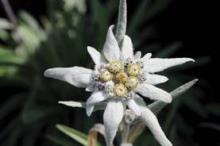Leontopodium alpinum, better known as edelweiss (German for noble whiteness and understood as noble purity) is a European mountain flower and member of the sunflower family long honored symbolically in national currency, badges, song, and other forms of national pride. It is also the national flower of Switzerland. Of medical interest, the plant has been used in traditional folk medicine to treat abdominal and respiratory disorders.
In 2003, Dobner et al. assessed the antimicrobial activity of extracts and various individual constituents of edelweiss. Using agar diffusion assays as well as the microbroth dilution method to determine minimum inhibitory concentrations, they observed significant antimicrobial activities exhibited against Enterococcus faecium, Escherichia coli, Pseudomonas aeruginosa, Staphylococcus aureus, Streptococcus pneumoniae, and Streptococcus pyogenes strains. The investigators concluded that their findings buttress the previously observed traditional folk medicine approaches to abdominal and respiratory conditions (J. Ethnopharmacol. 2003;89:301-3).
Dermatologic Applications
In 2004, some of the same researchers conducted a study using Leontopodium alpinum that offered dermatologic implications. Specifically, they examined the aerial (that is, capitula, inflorescence leaves, stems, stem leaves and leaves of the basal rosette; Phytochem. Anal. 2006;17:291-8) parts of edelweiss for their in vivo topical anti-inflammatory activity on Croton oil–induced ear dermatitis in mice. They found that dichloromethane extract yielded a dose-dependent decrease in edema, with the extract imparting greater activity than methanol and 70% aqueous methanol extracts. Dichloromethane extracts from the aerial parts of the plant were also found to be more active than dichloromethane root extracts. The investigators noted that fatty acids contribute significantly to the anti-edema effect of the aerial dichloromethane extract while the anti-inflammatory activity of the root extract could be attributed to bisabolane sesquiterpenes, tricyclic sesquiterpenes, coumarins and lignans (Planta Med. 2004;70:502-8).
In May 2006, some of the same researchers assessed the anti-inflammatory and analgesic effects of the dichloromethane, methanolic and carbon dioxide extracts of the aerial parts and roots of edelweiss after oral administration to rats and mice. In pretreated specimens, histologic examination of the paws of rats revealed significant decreases in inflammation. In the rats’ paw edema assay, the most activity was seen in the lipophilic extracts of the aerial plant parts, with swelling diminished by 80% from the dichloromethane extract and 72% from the carbon dioxide extract. Analgesic effects were more salient in association with treatment from the root extracts, compared with the aerial parts, which the authors suggested was indicative of varying mechanisms of action. Also, they evaluated the antioxidant properties of some of the extracts to ascertain any correlations with the observed anti-inflammatory characteristics (J. Ethnopharmacol. 2006;105:421-6).
Later that year, some of the same investigators, led by Schwaiger, identified and measured the major phenolic constituents of edelweiss. They compared retention times, UV, and mass spectra of nearly all separated constituents to commercially available reference compounds or those isolated from the plant using column chromatography. Among the constituent compounds of edelweiss were found several known antioxidants, including quercetin-3-O-beta-D-glucoside, luteolin-7-O-beta-D-glucoside, luteolin-3'-O-beta-D-glucoside, luteolin-4'-O-beta-D-glucoside, apigenin-7-O-beta-D-glucoside, 6-hydroxy-luteolin-7-O-beta-D-glucoside, luteolin-7,4'-di-O-beta-D-glucoside, chrysoeriol-7-O-beta-D-glucoside, leontopodic acid and 3,5-dicaffeoylquinic acid. A new natural product [3,4,5-tri-(E)-caffeoly-D-glucaric acid] was also identified in the process and named leontopodic acid B (Phytochem Anal. 2006;17:291-8).
In 2009, some of the same investigators, led by Costa, assessed the chemopreventive effects of the antioxidant leontopodic acid isolated from Leontopodium alpinum. After pretreatment with leontopodic acid, they assessed different mycotoxins in two different cell lines, aflatoxin B1 on HepG2 cells and deoxynivalenol on U937 cells. Leontopodic acid was shown to have protected U937 cells from deoxynivalenol-induced cell damage; it did not protect HepG2 cells from aflatoxin B1 toxicity. The researchers also found that the edelweiss isolate enhanced glutathione peroxidase activity in U937; it had no such effect on glutathione S-transferase activity in HepG2. They concluded that the primary mechanism of antioxidant-associated chemopreventive activity imparted by leontopodic acid is the elevation of detoxifying enzymes (J. Appl. Toxicol. 2009;29:7-14).
Products
Scar and Stretch Mark Body Cream is a new formulation launched by Dr. H. Bellin Swiss Skin Care that is touted for containing various peptides, hyaluronic acid, some forms of vitamin B, and Swiss edelweiss extract. Edelweiss extract is also a featured ingredient in the company’s new All in One Eye Cream and All in One Face Cream. The company claims that skin cell regeneration is stimulated by edelweiss. The alpine plant is also featured in Fabulous Eye Cream, a new product from MyChelle Dermaceuticals that they tout for its capacity to reduce collagen degradation and loss of skin firmness. Finally, Athanor products offers a line of edelweiss products, including an anti-aging cream, cleansing lotion, anti-aging serum, peeling mask, as well as neck and breast skin care lotions.


